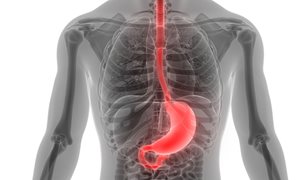
OP Oost has awarded funding of more than €1.2 million to four companies and three hospitals to continue the development and clinical application of an electronic nose with artificial intelligence. This system can detect the presence of pathogenic stomach bacteria by analyzing exhaled breath. The funding is intended to support product development up to the market introduction phase. To ensure that the electronic nose can be used to perform reliable tests in practice, the breath profiles of 2,000 people will be analyzed.
The bacterium Helicobacter pylori is a troublesome microorganism. If it becomes established in the stomach, the bacterium can cause severe problems. It damages the stomach wall, often resulting in a stomach ulcer. In the long term, it can even lead to stomach cancer. Luckily, H. pylori, as the bacterium is also known, can be treated quickly and effectively with antibiotics. The medical world has therefore devised various ways to detect the pathogen.OP Oost incentivizes innovation
The first step, of course, is to determine whether someone has H. pylori in their stomach. A number of methods are available for this, such as blood and stool tests. However, a consortium of four companies and three hospitals believes that this testing can be done differently: better, faster and less invasively. The consortium has therefore developed an electronic nose with artificial intelligence, known as the Aeonose, which can detect indicators of the bacterium in exhaled breath. Initial results at the Bernhoven hospital in Uden have demonstrated the effectiveness of this new approach. OP Oost has awarded the consortium more than €1.2 million to continue development up to the introduction of the Aeonose in clinical practice.
OP Oost, which falls under the European Regional Development Fund (ERDF), incentivizes companies in the provinces of Overijssel and Gelderland to develop and manufacture new, innovative products. This in turn helps to strengthen the regional economy.
Characteristic breath profiles
According to André Elands, director of the eNose company, the Aeonose uses sensors that measure a characteristic profile based on thousands of volatile organic compounds in exhaled breath. “What matters,” he says, “is the difference in breath profiles between people with and without H. pylori in their stomachs. To continue the development of this product, you need large numbers of patients and a neural network that can handle large amounts of data. This will result in an algorithm to indicate whether or not someone has that bacterium in their stomach. It is a self-learning system. It becomes smarter and better through more data and intensive use. We currently have approximately 30,000 breath profiles for various disorders. Specifically for the analysis of H. pylori, we already more than 500 profiles. To ensure a reliable clinical test, in this project we will analyze the breath profiles of 2000 people.”
Current detection techniques
In several other countries, up to 70% of the residents are carriers of the pathogenic bacteria. In the Netherlands this is around 15%, but that percentage is higher for people with a migration background. Because the infection does not cause severe symptoms in most people, it is often unclear whether or not somebody is carrying the bacterium. Only testing provides certainty.
Professor Peter Siersema, gastroenterologist at Radboud university medical center, lists some of the currently used tests: “There are breath tests in which people ingest urea. H. pylori loves urea and ‘eats’ it immediately. The characteristic waste materials from that bacterial meal can then be measured in the exhaled air. But this is a laborious method that sometimes involves radioactive substances.”
Gastroscopy and blood and stool tests
Foreign bacteria, such as H. pylori, elicit an immune response in the body. Clinicians can detect that immune response in blood by identifying antibodies, but this method also has disadvantages. Siersema: “Immediately after infection, no antibodies are present in the blood as yet. These can be detected later, but of course you want to ascertain whether or not the bacterium is present as quickly as possible. In short, this not an ideal test either.” The same applies to the detection of H. pylori in the stool. “This is fairly laborious method,” says Siersema, “which aims to detect genetic material from the bacteria. There are also disadvantages to this approach.” If there are clear indications of infection, gastroscopy is another option. A gastroscope is inserted into the stomach through the mouth. The surgeon then takes a biopsy from the stomach wall, which is then tested for the presence of bacteria. But this test is invasive and often unpleasant.
Volatile biopsy
It may sound strange: determining the presence of a bacterium in the stomach with air coming from the lungs. But this is a credible idea, says Siersema: “Gas always escapes from the stomach, for example when you burp. In addition, all kinds of blood gases are released into the lungs. These are gases that are picked up by the blood throughout the body and released into the lungs. In that respect, exhaled breath can reveal the state of our body.”
“That's right,” says Elands. “We also use the Aeonose to detect indicators of thyroid cancer in the breath, for example. And the thyroid gland has no direct connection to the lungs.”
In addition to Radboud university medical center, the participants in the project are the Bernhoven and Isala hospitals, Auxzenze, Next Generation Technology and Medlon. All participants have important roles in preparing the Aeonose for implementation in clinical practice. The device must not only be reliable, but also easy to use, and it must be able to communicate directly the other software programs used in healthcare.
This research is conducted within the theme Tumors of the digestive tract.
Related news items

Electronic nose smells precursor of oesophageal cancer
5 March 2020 A portable electronic nose can effectively detect precursors of oesophageal cancer, reported by RIHS researchers Yonne Peters and Peter Siersema in the medical science journal GUT. This was demonstrated in an initial study involving more than four hundred patients. go to page
Mohrmann Stipend for Bakker and Peters
12 December 2019 Tuesday 10 December, Esmée Bakker and Yonne Peters were awarded a Christine Mohrmann stipend. The grant – 5000 euros each – gives them an opportunity to spend time at another university, preferably one abroad. go to page
Barrett oesophagus
6 June 2019 In Nature Reviews Disease Primers Yonne Peters and Ali Al-Kaabi provided a global overview of Barrett oesophagus and outlined key open research questions. This primer covered epidemiology, disease mechanism, diagnose, screening, prevention, management, and quality of life. go to page
How to approach a patient with refractory or recurrent benign esophageal stricture
31 January 2019 In Gastroenterology Peter Siersema described the currently used treatment modalities for complex esophageal strictures, based on underlying cause and symptom duration, but also focusing on future treatment perspectives. go to page
Low risk of progression in persistent non-dysplastic Barrett’s esophagus
19 September 2018 In Clinical Gastroenterology and Hepatology Peter Siersema and Yonne Peters showed that patients with stable persistence of non-dysplastic Barrett’s esophagus have a low risk of malignant progression and may not benefit from routine endoscopic surveillance. go to page
